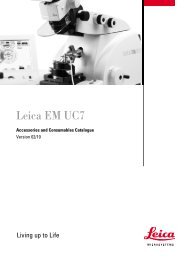Physical Principles of Electron Microscopy: An Introduction to TEM ...
Physical Principles of Electron Microscopy: An Introduction to TEM ...
Physical Principles of Electron Microscopy: An Introduction to TEM ...
You also want an ePaper? Increase the reach of your titles
YUMPU automatically turns print PDFs into web optimized ePapers that Google loves.
xii<br />
Preface<br />
textbooks, such as Williams and Carter (1996) and the excellent Springer<br />
books by Reimer. Even so, I hope that some <strong>of</strong> my research colleagues may<br />
find the current book <strong>to</strong> be a useful supplement <strong>to</strong> their collection.<br />
My aim has been <strong>to</strong> teach general concepts, such as how a magnetic lens<br />
focuses electrons, without getting in<strong>to</strong> <strong>to</strong>o much detail � as would be needed<br />
<strong>to</strong> actually design a magnetic lens. Because electron microscopy is<br />
interdisciplinary, both in technique and application, the physical principles<br />
being discussed involve not only physics but also aspects <strong>of</strong> chemistry,<br />
electronics, and spectroscopy. I have included a short final chapter outlining<br />
some recent or more advanced techniques, <strong>to</strong> illustrate the fact that electron<br />
microscopy is a “living” subject that is still undergoing development.<br />
Although the text contains equations, the mathematics is restricted <strong>to</strong><br />
simple algebra, trigonometry, and calculus. SI units are utilized throughout.<br />
I have used italics for emphasis and bold characters <strong>to</strong> mark technical terms<br />
when they first appear. On a philosophical note: although wave mechanics<br />
has proved invaluable for accurately calculating the properties <strong>of</strong> electrons,<br />
classical physics provides a more intuitive description at an elementary level.<br />
Except with regard <strong>to</strong> diffraction effects, I have assumed the electron <strong>to</strong> be a<br />
particle, even when treating “phase contrast” images. I hope Einstein would<br />
approve.<br />
To reduce publishing costs, the manuscript was prepared as camera-ready<br />
copy. I am indebted <strong>to</strong> several colleagues for pro<strong>of</strong>reading and suggesting<br />
changes <strong>to</strong> the text; in particular, Drs. Marek Malac, Al Meldrum, Robert<br />
Wolkow, and Rodney Herring, and graduate students Julie Qian, Peng Li,<br />
and Feng Wang.<br />
January 2005<br />
Ray Eger<strong>to</strong>n<br />
University <strong>of</strong> Alberta<br />
Edmon<strong>to</strong>n, Canada<br />
reger<strong>to</strong>n@ualberta.ca



